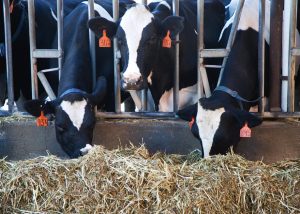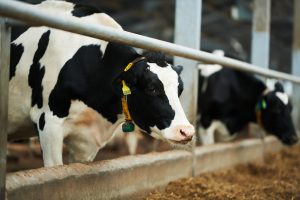Alvaro Garcia
Under ideal conditions livestock should always be offered feedstuffs that are free of fungi and/or mycotoxins. There are certain times and/or seasons however when this can become a challenge. From plant growth in the field, harvest, and later to storage, there are ample opportunities for molds to grow on cereal grains. Their spores are everywhere, in the air, soil, and farm equipment, and they germinate when the conditions are right.
Mold spores are opportunistic organisms that proliferate in stressed, weakened or damaged plant material. Plants or grains damaged or weakened by adverse environmental conditions or pests are perfect targets for mycotoxin-producing fungus.
Mold and mycotoxins in feeds
When it comes to dealing with mycotoxins the fact that livestock diets usually contain multiple ingredients can be viewed both from a positive and negative standpoint. More feedstuffs dilute one contaminated feed, making the overall diet safer. On the other hand, if there are multiple contaminated feeds, the toxicity of one individual feed can also be heightened.
There are three main genera of molds that affect livestock: Aspergillus, Fusarium, and Penicillium. The primary toxins of concern are aflatoxin B1, zearalenone, deoxynivalenol (DON), trichothecenes, fumonisins (especially B1), ochratoxin A, diacetoxyscirpenol (DAS), Nivalenol (NIV), and patulin. Some are produced on the plant pre-harvest (such as the ones from Aspergillus and Fusarium), others post-harvest during storage and transportation, such as ochratoxin A (sometimes aflatoxins and others depending on the feed).
Mycotoxins can also cause chronic diseases in animals with effects targeting different organs and systems (hepatotoxicity, genotoxicity, nephrotoxicity, neurotoxicity, reprotoxicity, immunotoxicity, etc.). Non-specific effects that result from chronic intoxication have a negative effect on animal health, resulting in a heightened susceptibility to disease and impaired performance.
Aspergillus (A. flavus and A. parasiticus) produce mycotoxins known as aflatoxins. Four aflatoxins can be found in livestock feeds, namely B1, B2, G1, and G2. The most common and biologically active component is aflatoxin B1, a potent carcinogen. Rumen microorganisms can degrade up to 42% of aflatoxin B1, but they are also capable of producing aflatoxicol. A liver metabolite of B1 called aflatoxin M1 can show up in milk and is of concern in humans since it is also a potent carcinogen.
Aflatoxin M1, is produced from B1 in the liver and can end up in the rumen through the rumino-hepatic circulation. The toxicity of aflatoxicol and M1 is like that of B1, and they are readily absorbed by the intestine. Therefore, even when B1 is degraded in the rumen to aflatoxicol and transformed in the liver to M1, the toxic end-result is similar. The metabolite M1 circulates from the liver into the blood and ends up in milk or urine.
Fusarium type of molds produce deoxynivalenol (DON), zearalenone, trichothecenes, and fumonisin. Zearalenone is degraded in the rumen by protozoa to α-zearalenol, which has high estrogenic activity, and to β-zearalenol, a product toxic to the endometrium. The main effects of zearalenone in cattle are thus related to reproductive problems such as embryo survival, infertility, hypertrophy of the genitalia, and feminization in young males (reduced testosterone).
Trichothecenes also derive from the fusarium group of molds, which include diacetoxyscirpenol (DAS), T-2 toxin, HT-2 toxin, nivalenol, and deoxynivalenol (DON); these molds have been associated with gastrointestinal lesions in dairy cows. Trichothecenes have been well known for their impact on the cow’s immune system.
Healthy dairy cows usually tolerate moderate amounts of molds in feed unless they are immunosuppressed. Stresses that impair the immune function increase their susceptibility to mycotoxicosis. Both aflatoxins and trichothecenes affect immuno-suppression. Effects that have been described include reductions in cellular protein synthesis, cell mediated immunity, and antibody production. It is thus very important to decrease the mycotoxin concentration to boost the immunity of the animal by reducing overall stress.
Reinforcing the diet with antioxidant compounds (e.g., selenium, vitamins A and E, beta carotenes, etc.) above and beyond the daily nutritional requirements of the animal help because of their ability to scavenge superoxide anions. Fumonisins seem to be better tolerated by ruminants however, feed intake and milk production can also be negatively affected. Ochratoxin A, which is degraded in the rumen, is of little consequence for ruminants. Patulin is commonly found in silages, and sudden exposure to patulin may result in reduced feed intake and milk production.
High Penicillium counts are oftentimes seen in feeds such as corn grain and corn silage. There are almost 100 Penicillium fungus species, but only 17 have been found to produce mycotoxins of concern. The main toxins are ochratoxin A, patulin, PR toxin, mycophenolic acid, and roquefortine C. Their effects depend on the stress and/or the presence of other mycotoxins that challenge immunity.
While some Penicillium fungus may not normally cause health problems they can, under certain circumstances, result in damage to the liver and/or kidneys in presence of other mycotoxins. High concentrations may also cause other non-metabolic related problems. For example, off-smell in feed can result in feed sorting, leading to acidosis and displaced abomasum both in beef and dairy cattle.
If high Penicillium type molds are present, it is advisable to test to determine if other mycotoxins are also present. Ochratoxin produced by Penicillium is usually degraded in the rumen, which reduces its toxic effects. It is thus more toxic to young calves without a well-developed rumen fermentation critical to the “detoxification” process.
With heavy grain supplementation in adult cows however, this toxin can remain in the rumen, appear in blood, and end damaging the kidneys. Limit-feed corn grain with high Penicillium levels in mature cows and avoid feeding it altogether to young stock.
At the present time, the Food and Drug Administration (FDA) has not established action levels for zearalenone. It has been suggested that the concern level should be around 560 ppb for both individual ingredients and the total diets. This concentration suggests that the conditions for mycotoxins to develop are favorable and thus it is suggested to test both the diet and individual feeds.
Animal performance should be monitored closely together with the appearance of clinical signs. If the effects are subtle the amount of feed offered can be reduced but always closely monitoring performance and the appearance of any clinical signs such as the ones described above. When concentrations are above that concern level animal performance and clinical signs need to be monitored even more closely and it may be necessary to discontinue the use of that feed.
Testing for mycotoxins
There are several testing options for mycotoxins available in the market. Some of them are usually quick, less expensive tests, while there are other more sophisticated and precise, but that take more time. The methods currently in use are the enzyme-linked immunosorbent assays (ELISA), Lateral Flow Test, High Performance Liquid Chromatography (HPLC), and modifications of the latter such as liquid chromatography coupled to mass spectrometry (LC-MS) or tandem mass spectrometry (LC-MS/MS), and Near Infrared Spectrometry (NIR). Rapid tests like ELISA are still acceptable for testing feedstuffs with accuracy on-site, particularly when testing for the most frequent mycotoxins.
It is recommended that they be used as a rapid screening test that, when positive, can be followed by a more detailed and lengthy method to confirm their presence and concentration. Tests as the ones’ mentioned above (LC-MS/MS) will give the consultant, feed mill or farmer a better understanding of the varied mycotoxins at play and their potential health impact. Let us take a quick look at each method and their characteristics.
ELISA
The ELISA method has been in the market for a while and is considered very reliable. It is a very good method when mycotoxins are suspected in the feed. There is a limit of up to six mycotoxins tested per extraction which is usually enough to cover the most frequent toxins present. Its main advantage is its low cost per sample, and that it uses test kits with very fast incubation time (15’). Since the kit is set for 30 samples however, when testing just 1-2 feeds one loses the advantage of the low cost per individual feed.
Lateral Flow Test
The Lateral flow test also called strip test is user-friendly and rapid. The original test uses a solvent, but others use water instead, which is a clear advantage over using flammable liquids that also must be disposed of properly. It tests individual feeds and only four mycotoxins can be detected (aflatoxins, deoxynivalenol, zearalenone and fumonisins). It is composed of a sample pad, a conjugate pad, a membrane, an absorbent pad and an adhesive backing. Like the ELISA test, it is also a competitive reaction scheme that tests for small molecules with single antigens.
High Performance Liquid Chromatography (HPLC)
The HPLC consists of a tube circuit that applies pressure with a pump pushing the mix of sample and solvent through a special column filled with a solid adsorbent material. The mycotoxins interact with the adsorbent in the column at different rates allowing for a gradient separation as they go through. Mycotoxins are then quantified by a detector comparing them to known standards. Different detectors can be used such as refractometers, spectrophotometers, mass spectrometers, and fluorescence detectors. The HPLC method is highly sensitive, reliable and precise, and uses a very small amounts of samples making it the gold standard for research and commercial applications.
The other last two methods mentioned above, the liquid chromatography coupled to mass spectrometry (LC-MS) or tandem mass spectrometry (LC-MS/MS). Combine the separation capabilities of the HPLC with the detection of the mass or other features of the feed sample.
Near Infrared Refractory Spectrometry
Near Infrared Refractory Spectrometry (NIR) analyzes the interaction between an infrared electromagnetic radiation (near-infrared region of light at 800-1200 nm) applied to a sample with chemical bonds in the latter. Once the radiation is applied to the sample it reflects it in specific ways that allow to predict the molecular composition and the chemical bonds present which are compared to predetermined standards.
The calibration with a large database of samples previously tested through HPLC or its modifications is needed. Mathematical algorithms are applied to eliminate “noise” and drifts. It is considered a useful method to screen samples as containing high or low concentrations in aflatoxins but cannot measure the mycotoxins themselves (low molecular mass), and thus not considered a method of choice.
© 2020 Dairy Knowledge Center. All Rights Reserved.









